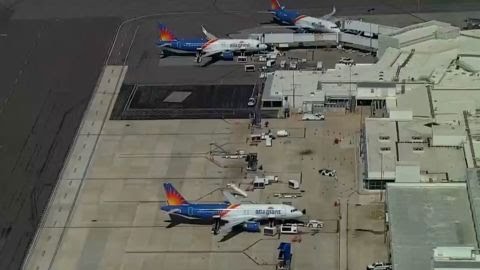
Passengers and crew on Allegiant Air Flight 227 experienced a terrifying ordeal as severe turbulence rocked the aircraft during its descent into St. Pete-Clearwater International Airport. The flight, which had departed from Asheville, North Carolina, encountered unexpectedly rough air, resulting in injuries to four people, including two passengers and two crew members. The incident underscores the unpredictability of turbulence and its potential impact on flight safety, even in otherwise routine conditions.

According to the Federal Aviation Administration (FAA), the aircraft was nearing the end of its journey when the turbulence struck. Passengers reported that the jolt came out of nowhere, launching unprepared flight attendants into the air and causing visible injuries. “It was petrifying,” Lisa Spriggs, a passenger on the flight, shared. “More than halfway through descending, and all of a sudden, we hit a small turbulence, and the stewardess beside us fell to the ground.” Spriggs described the scene as something reminiscent of a movie — surreal and frightening. “It was like ‘The Matrix.’ [We] watched her go up in the air and land straight down.”
The plane, carrying 179 passengers and six crew members, was able to complete its descent and land without further issues. Despite the turbulence’s severity, the aircraft managed to land normally, taxiing to the gate under its own power. At the gate, medical personnel were on hand, ready to provide assistance. Two passengers and two flight attendants were subsequently transported to a nearby hospital for additional evaluation, though the full extent of their injuries has not been disclosed.
The turbulence was severe enough to cause visible injuries among several passengers, leaving some bloodied and shaken. One passenger recounted the chaotic moments after the turbulence hit, recalling a woman who had been in the bathroom at the time of impact. “Some lady was in the bathroom during the time of the turbulence, and she came out and sat down behind me,” he said. “She had a huge laceration on her right eyebrow, gushing out blood.” Such descriptions bring into sharp focus the danger that turbulence can pose, especially when passengers or crew are unrestrained.
For those who were injured, the ordeal was more than just a brief moment of discomfort. In some cases, passengers reported broken bones and deep cuts. The incident serves as a reminder of how even short episodes of turbulence can lead to severe injuries, particularly when passengers or crew members are caught off guard. Experts point out that although turbulence is a common occurrence during flights, severe turbulence can be unpredictable and may happen with little warning, as appears to have been the case with Allegiant Air Flight 227.
For many of those onboard, the experience was a wake-up call about the realities of turbulence and the importance of staying seated with seat belts fastened whenever possible. Turbulence is often dismissed as a minor annoyance by frequent flyers, but this incident highlights the potential risks when severe turbulence strikes unexpectedly. Lisa Spriggs and others on the flight noted the emotional toll the incident took, describing it as surreal and frightening. “You hear about it happening, but you never think, ‘Oh, that’s the TV, it’s movies.’ But it’s terrifying,” Spriggs admitted.
While Allegiant Air and the FAA have committed to investigating the incident, turbulence remains a phenomenon that’s challenging to predict with certainty. Meteorologists and aviation experts work continuously to track and report areas of potential turbulence, but sudden weather patterns and air currents can still catch flight crews by surprise. Turbulence tends to be more common in areas with rapidly changing weather or mountainous terrain, though it can occur at any altitude and in nearly any location.
Reports of turbulence incidents have been on the rise, partly due to more flights and more intense weather patterns influenced by climate change. As warm and cold air masses interact more frequently and violently, the result can be sudden shifts in air pressure that create unpredictable, turbulent zones. This puts additional pressure on pilots and airline operators to remain vigilant and take preventative measures wherever possible, though it’s often challenging to predict every moment of turbulence with precision.
In response to increasing turbulence incidents, some airlines have invested in enhanced onboard technology that can help detect turbulence in advance. For example, advanced weather radar systems can sometimes identify areas of potential turbulence, allowing pilots to alter their routes or prepare passengers and crew accordingly. However, these systems are not foolproof, and unanticipated turbulence, particularly during landing or takeoff, remains a real and pressing challenge.
For passengers on Allegiant Air Flight 227, the incident will likely linger as a reminder of the potential hazards of air travel, even on what might initially seem like a routine flight. In recent years, turbulence-related injuries have become more common, especially as airlines operate more flights and air traffic increases. The aviation industry continues to work on ways to improve turbulence detection and minimize its impact, but as this flight demonstrated, turbulence is a reality that cannot always be avoided.
In the wake of this incident, many passengers are expressing gratitude that the situation wasn’t more severe. “I think we’re all just thankful that it wasn’t worse,” Spriggs said. For the injured crew members and passengers, the recovery process will likely take time, and Allegiant Air has pledged to provide support as needed. The airline and FAA will likely review flight data and weather conditions from the incident to determine if any procedural or safety adjustments can be made.
While turbulence may be a known hazard in aviation, this incident serves as a powerful reminder of the importance of following safety protocols, such as wearing seat belts whenever seated, and remaining vigilant as passengers. For many on board, the incident was a shocking encounter with the unpredictable side of air travel, underscoring that while the skies may be generally safe, they’re not without their risks.